When Triumph introduced its radical (for them, anyway) new Thunderbird last year, its sights were set firmly on Harley-Davidson. Of course, to beat the standard bearer it helps to think outside the box and try something different.
Refusing to copy the trend of virtually every cruiser on the market today, the boys in Hinckley decided to power the Thunderbird with a parallel-Twin engine instead of the venerable V-Twin. Not only that, but Triumph took its expertise in parallel-Twins and produced the largest production version ever made – one that left a rather positive impression on our very own Kevin Duke, leaving him more impressed than he thought he’d be during the bike’s world introduction in Spain.
For the new year, Triumph is taking a page out of America’s book and upping the ante with the new Thunderbird Storm. Simply put, while the T-Bird is an elegant, respectful cruiser, the Storm is a certifiable badass.
The first thing you’ll probably notice is its blacked-out decor. The Storm is all about attitude, and nothing defines attitude on a cruiser like ditching the chrome and going black. Starting at the front, the fork stanchions, brake calipers, Speed Triple-style dual headlights, turn indicators, bar risers, gauge bezel, engine cover, chain guard, shock springs, rear sprocket and both wheels all receive the black treatment.
But as the saying goes, there’s no replacement for displacement, and the optional 1700cc big-bore kit available on the Thunderbird is now fitted standard on the Storm. That kit includes the obvious larger pistons, revised camshafts, larger piston rings, new cylinder liners, gudgeon pins, and gaskets. Uprated clutch springs are also included to deal with the bump in power. Those considering the T-Bird still should be warned: it still comes with the smaller engine.
What does that equate to? Try a claimed 12-horsepower bump (85 vs. 97) and 7 more ft-lb of torque (108 vs. 115) compared to the standard T-Bird. Triumph representatives were quick to point out the dyno chart overlay, which shows the Storm’s clear advantage in power and torque throughout the rev range as one would expect.
The rest of the engine characteristics remain the same: it’s still liquid-cooled with dual overhead camshafts and a 270-degree firing interval that, especially with the Triumph accessory exhaust system, sounds oddly similar to a certain American V-Twin exhaust note from Milwaukee. Compression ratio is 9.7:1, and petrol is fed to the cylinders via fuel injection. In fact, the rest of the Storm is practically blacked-out T-Bird as well.
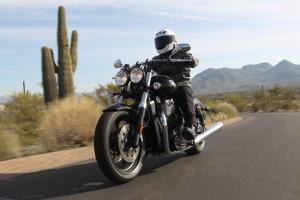 Triumph chose to introduce the Storm to the North American press near Scottsdale, Arizona where the open roads would provide a great opportunity to stretch its legs.
Triumph chose to introduce the Storm to the North American press near Scottsdale, Arizona where the open roads would provide a great opportunity to stretch its legs. Before ever throwing a leg over the bike, I took a step back and just admired its looks. Styling is such a subjective topic, but my initial reaction is that Triumph did its homework on how to style an aggressive cruiser that still keeps its distinctive character. To validate my point, sitting outside the hotel were a few Storms attracting attention from fellow hotel guests covering virtually the entire age spectrum, both men and women. Oddly enough, the Storm attracts attention for its lack of chrome the same way the T-Bird does for its abundance of it.
With all the gawking out of the way, I finally had a chance to throw a leg over the Storm. Not surprisingly, being a cruiser, the reach to the ground wasn’t very far—27.5 inches, to be exact. Usually at this point I come to realize that someone of my stature—5’8”, 30-inch inseam—doesn’t have the typical cruiser build as the bars are typically a long reach for my arms and the shifter is a stretch too. Not so on the Storm.
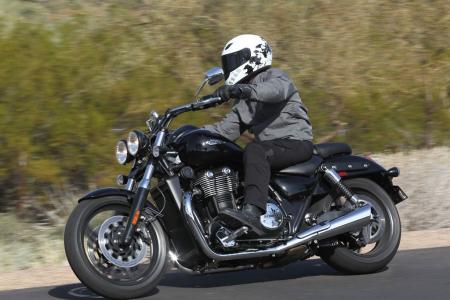 A parallel-Twin engine means the rider can sit closer to the front of the motorcycle. Revised bar risers on the Storm also alter bar position slightly from the Thunderbird. Overall, it proved to be a comfortable combination. A parallel-Twin engine means the rider can sit closer to the front of the motorcycle. Revised bar risers on the Storm also alter bar position slightly from the Thunderbird. Overall, it proved to be a comfortable combination. |
Because the cylinders are side-by-side and not in a V-angle, the seat is allowed to be closer to the bars via a fuel tank that doesn’t need to be stretched to cover the front cylinder, like on a V-Twin. The Storm also benefits from slightly revised bar risers, which doesn’t change the distance to the bars, but tweaks the bar position just a smidge. This puts a rider my size into a comfortable, natural position.
But I realized I was too quick to judge my stature. Both the brake and clutch levers were a reach for my hands, something I notice on cruisers across the board. Unfortunately, these units aren’t adjustable.
Thumb the starter and it’s impressive how composed the 1699cc parallel-twin engine is. Twin counterbalancers quell vibes from the inherently buzzy engine configuration. My focus shifts solely to the engine once rolling. The 1700cc mill is the centerpiece of the entire bike and it demands attention. Each twist of the throttle delivers a sense of immediacy to the belt-driven rear wheel that’s felt throughout the entire body. It doesn’t matter which of the six gears you’re in, the broad spread of torque gets the Storm accelerating in a hurry. With enough open road the short gearing of the first five cogs will be used quickly, but the tall gearing of sixth makes it ideal to be overdriven.
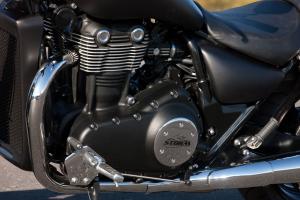 Once over the engine, the rest of the Storm makes itself heard. The transmission can be notchy at times, but never was a shift missed. There are some interesting touches like the instrument cluster situated (in black, of course) on the fuel tank, with a speedometer that dominates. The interesting bit is the tachometer, which can easily be mistaken as a fuel gauge as it’s significantly smaller and sits just underneath the speedo. Needless to say, it was difficult to read, but I do appreciate its presence. Our trek would eventually lead us to Canyon Lake, where the roads, while twisty, could have used a bit of upkeep.
Once over the engine, the rest of the Storm makes itself heard. The transmission can be notchy at times, but never was a shift missed. There are some interesting touches like the instrument cluster situated (in black, of course) on the fuel tank, with a speedometer that dominates. The interesting bit is the tachometer, which can easily be mistaken as a fuel gauge as it’s significantly smaller and sits just underneath the speedo. Needless to say, it was difficult to read, but I do appreciate its presence. Our trek would eventually lead us to Canyon Lake, where the roads, while twisty, could have used a bit of upkeep. In the tight stuff, the Storm was impressive (for a cruiser anyway). It has balanced turn-in and holds a line well thanks to its 151mm trail. Suspension, which consists of a 47mm Showa fork in front and dual shocks in the rear, provided 4.7 and 3.7 inches of travel, respectively. The units are non-adjustable save for preload adjustment in the rear.
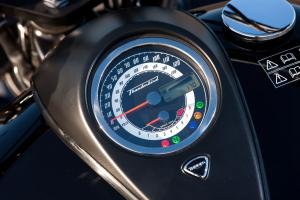 Suspension performance was a bit of an anomaly. Its highway manners were perfect and provided a comfortable and plush ride. The bumpy bits surrounding Canyon Lake transformed the bike’s manners, however. Both ends would rebound quickly over jolts in the road, though granted it was only while riding over the harshest ones. Couple that with a saddle that’s filled with rather firm foam, and it’s best to look for the route with the best-kept pavement.
Suspension performance was a bit of an anomaly. Its highway manners were perfect and provided a comfortable and plush ride. The bumpy bits surrounding Canyon Lake transformed the bike’s manners, however. Both ends would rebound quickly over jolts in the road, though granted it was only while riding over the harshest ones. Couple that with a saddle that’s filled with rather firm foam, and it’s best to look for the route with the best-kept pavement. While the Storm is all about increasing forward momentum, every now and then coming to a halt is important too, and the Storm offers a worry-free and impressive show, which is something not normally associated with motorcycles in this class. Twin 310mm floating discs up front are each mated to Nissin four-piston calipers, while the rear 310mm fixed disc is mated to a two-piston Brembo caliper. The front binders alone provide decent stopping power, but tap the rear brake lever also and you have stopping power that feels sportbike-like.
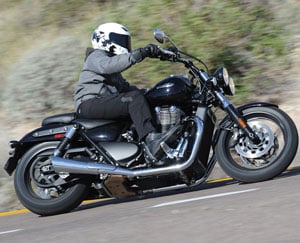 The Storm is surprisingly well behaved in the tight stuff. Turn-in is relatively quick, and once leaned over it holds a line well. There’s even an impressive amount of lean angle available before hard parts touch down. The Storm is surprisingly well behaved in the tight stuff. Turn-in is relatively quick, and once leaned over it holds a line well. There’s even an impressive amount of lean angle available before hard parts touch down. | 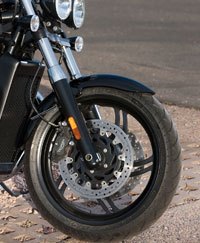 We don’t understand why cruisers tend to neglect stopping power. Thankfully Triumph decided to buck that trend with 310mm rotors front and rear. We don’t understand why cruisers tend to neglect stopping power. Thankfully Triumph decided to buck that trend with 310mm rotors front and rear. |
All in all Triumph is on a roll as of late, with its diversity plan reaching a long range of riders. Taking the fight straight to Harley-Davidson and the cruiser market with the Storm (and the Thunderbird) is a bold move, but it’s one I’m convinced will be much closer than people think.
The Storm is available in any color as long as it’s black, but at least we get the choice between Matt Black or Jet Black. Either one will set you back $13,899.
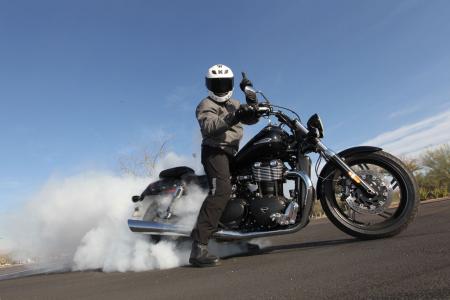 When a bike has this much attitude, there’s only one way to send it off. When a bike has this much attitude, there’s only one way to send it off. |



 9:55 PM
9:55 PM
 Unknown
Unknown


 Posted in:
Posted in: 




0 comments:
Post a Comment